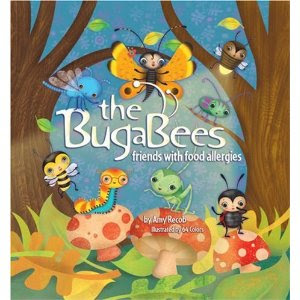We've been looking for books to help our son prepare for preschool. We wanted to increase his awareness, help him become an advocate for himself, and hopefully find a book that his teacher could read to his class to help them understand and be supportive.
Here's what we got through interlibrary loan and Amazon:
Cody the Allergic Cow by Nicole Smith
This is our favorite of all of the books. Though Cody is just allergic to milk, food-allergy issues like symptoms, being careful about what foods "hide" the allergen, feeling different than non-allergic friends and family members, and having the epi-pen close by are all covered. There are other books in this series that deal with peanuts and nuts. This book is great for my preschooler and it would be great for his teacher to share with the class as well.
The BugaBees: Friends with Food Allergies by Amy Recob
This beautifully illustrated rhyming children's book features 8 characters with different food allergies. Since my son shares 6 of those, we have plenty of opportunity for discussion about foods to which he is and is not allergic. This book is appropriate for children in the primary grades and would be great for a teacher to share with the class.
The Day I Met the Nuts by Mary Rand Hess
This is a cute book that describes nut allergies from a child's perspective. He goes through all the emotions: He's sick, scared, frustrated, he feels different and left out, and eventually he learns how to adapt. This book is appropriate for nut-allergic children of any age.
Food Allergies by Jason Glaser
This is more of a reference book for kids than it is a children's book. Teachers could effectively use this book to share with a class what food allergies are, what reactions look like, what causes them, etc. This book could be used from preschool through most of the elementary grades.
A Day at the Playground: A Food Allergy Awareness Book for the Young by Tracie Mulari-Schrand
This book is not specific to any particular food allergy. It's geared toward helping children be aware of food allergens in a play setting. It's age-appropriate for my 3-year old boy. It is a good cautionary read.
Taking Food Allergies to School by Ellen Weiner (Part of Kim Gosselin's Special Kids in School Series)
This book is very good at explaining how foods with an allergen make a food-allergic person sick, complete with talk of white blood cells, antibodies, and histamines. This is a great book to read and discuss with my food-allergic 8-year old but not with the 3-year old.






